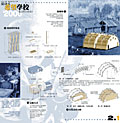 In
the mid-1990s, Team Minus brought together four young Chinese architects,
all teaching at the Tsinghua University School of Architecture. Team Minus
praxis cannot be understood without being referred back to the context of
present-day China: incredible economic development, and wholesale but anarchic
urban growth, leaving whole tracts of land in a state of under-development.
The Team Minus group is persuaded that architecture must play a major part
in the sustainable development of China, and accordingly explores two parallel
tracks in its projects: the use of state-of-the-art and so-called "clean"
technologies, at the service of alternative forms of architecture for the
most depressed regions; and use of the built environment as an educational
medium. This constructive ethic crops up in their project for a Moveable
School of Hope (Brian Chang and Brenda Yao, 2000). As part and parcel of
a Unesco-backed programme aimed at improving school conditions in poor areas,
this project proposes a twofold system of folding metal structures and modulable
constructive elements to house temporary, travelling schools. In
the mid-1990s, Team Minus brought together four young Chinese architects,
all teaching at the Tsinghua University School of Architecture. Team Minus
praxis cannot be understood without being referred back to the context of
present-day China: incredible economic development, and wholesale but anarchic
urban growth, leaving whole tracts of land in a state of under-development.
The Team Minus group is persuaded that architecture must play a major part
in the sustainable development of China, and accordingly explores two parallel
tracks in its projects: the use of state-of-the-art and so-called "clean"
technologies, at the service of alternative forms of architecture for the
most depressed regions; and use of the built environment as an educational
medium. This constructive ethic crops up in their project for a Moveable
School of Hope (Brian Chang and Brenda Yao, 2000). As part and parcel of
a Unesco-backed programme aimed at improving school conditions in poor areas,
this project proposes a twofold system of folding metal structures and modulable
constructive elements to house temporary, travelling schools. |

